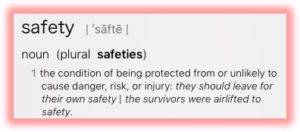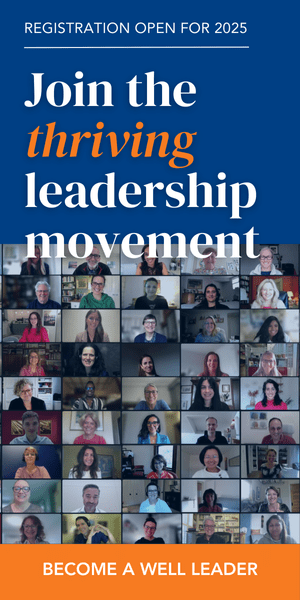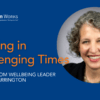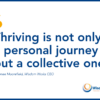 My first job at a global company was almost thirty years ago. Looking back on that time, I feel deeply indebted for the exposure I gained so early in my career—training in ethics and diversity, experiences with extraordinary teams, relationships with people from cultures across the world. I grew as a leader and human being through positive work at that company.
My first job at a global company was almost thirty years ago. Looking back on that time, I feel deeply indebted for the exposure I gained so early in my career—training in ethics and diversity, experiences with extraordinary teams, relationships with people from cultures across the world. I grew as a leader and human being through positive work at that company.
My growth came through navigating appalling moments too. As an example, when I didn’t agree with the views of one of my first bosses, he’d shout at me or jump on top of my desk to forcefully drive home his opinions. On more than one occasion our charged interactions left me in tears. I was a first-line leader, age 23, and stomached situations I cannot imagine putting up with under any circumstance now.
So, I feel encouraged by the outpouring of #MeToo, #BalanceTonPorc, #harassment, #mentalhealth, and like crusades across our workplaces today. Our organizations are microcosms of our societies—they are a reflection of us all. We’re in the middle of purging deep hurts, surfacing toxic power inequities, and shining a light on our vast ignorance. While we seek to transform the poisons in our workplaces, we also get an opportunity to up-level our ways of being and operating, starting within ourselves.
Let’s Stop Kidding Around
In my last blog, I shared a useful infographic from the Global Wellness Institute’s Wellness at Work Initiative to emphasize key building blocks for a culture of care and wellbeing. Foundational to these building blocks is an environment where people feel physically and psychologically safe. Because if employees don’t feel safe, then they are not thriving at work. It’s that critical.
What does safety mean?
A physically safe work environment is one where workers are “protected from sickness, disease and injury arising from their employment,” states the International Labour Organization. ILO estimates that each year over 2 million people die and another 650 million suffer from largely preventable work-related accidents and diseases—and the distress caused by such accidents and illness to workers, their families, and other close relationships is incalculable. Due to our lack of workplace safety globally, ILO claims 4-6% of the world’s annual GDP is lost.
A psychologically safe work environment is “a climate in which people are comfortable being and expressing themselves.” In her insightful TEDx Talk, Harvard Business School professor of leadership Amy Edmondson says simply, “No one wakes up in the morning to look ignorant, competent, intrusive, or negative.” No one pursues teams or work environments that are degrading. Yet, if you’ve been in the work world for any length of time, you likely found yourself stuck in situations that erode your mental and emotional wellbeing. You’ve lived through disrespect, distrust, destructive biases, and other undermining attitudes and behaviors these noxious work environments breed. Psychologically unsafe workplaces rob the very human potentials—creativity, trust, collaboration, learning, and positive meaning—that organizations and the people in them require to succeed and thrive.
We kid ourselves by promoting lofty activities for employee wellness, engagement, and productivity if we are not authentically creating workplaces with physical and psychological safety at the heart. It is time to take a deeper look at the organizations we’ve created, and ask:
Is this workplace safe for everyone it touches?
While you ponder this question, put your empathy gear on. Walk around it from different points of view. What answers might women in your organization give? How about people with disabilities? Employees from different ethnicities? Your older generation? Your incoming employees? Better yet, create a constructive approach where answers from each group in your organization are respected and heard. From a spirit of true inquiry, you’ll be amazed at the insights you learn for fostering a culture of trust, high performance, and wellbeing.
Are You Ready?
I believe the yearning to create, grow, and evolve is instilled within our nature as human beings. Organizations have unprecedented power to unleash these human potentials—for thriving, optimal performance, and positive global impact. That became clear to me at the start of my career many years ago, and it’s a conviction I still hold today. Great promise is in store for those leaders who are willing to earnestly ask: “How can we create the conditions where everyone can bring their best selves to work and leave work more capable and well than when they came?”
Interesting in learning more? Drop me an email at renee@wisdom-works.com.
READ MORE
- Ready To Build a Culture of Wellbeing: 3 Tools Can Help
- Three Illusions that May Prevent Your Deepest Wellbeing
- 3 Strategies to Unleash Your Potential As Leader And Whole Human Being
- Stop Action for Better Results: 3 Ways that Work
- The Pivot That Turns Challenge Into Growth
- Ready To Disrupt Yourself On Purpose? Try Uncentering!
- Your Inner Game Runs Your Outer Game
- Rewiring Yourself For Better Leadership And A Healthier Life (Part 1) and (Part 2)
- Shifting From Reactivity To Wellbeing






